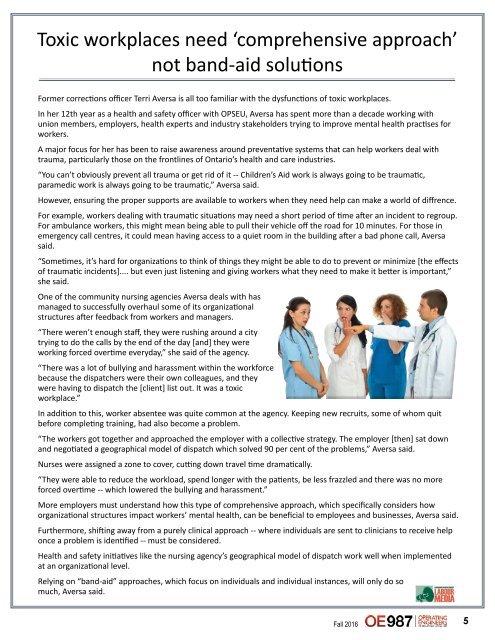You also want an ePaper? Increase the reach of your titles
YUMPU automatically turns print PDFs into web optimized ePapers that Google loves.
Toxic workplaces need ‘comprehensive approach’<br />
not band-aid solutions<br />
Former corrections officer Terri Aversa is all too familiar with the dysfunctions of toxic workplaces.<br />
In her 12th year as a health and safety officer with OPSEU, Aversa has spent more than a decade working with<br />
union members, employers, health experts and industry stakeholders trying to improve mental health practises for<br />
workers.<br />
A major focus for her has been to raise awareness around preventative systems that can help workers deal with<br />
trauma, particularly those on the frontlines of Ontario’s health and care industries.<br />
“You can’t obviously prevent all trauma or get rid of it -- Children’s Aid work is always going to be traumatic,<br />
paramedic work is always going to be traumatic,” Aversa said.<br />
However, ensuring the proper supports are available to workers when they need help can make a world of diffrence.<br />
For example, workers dealing with traumatic situations may need a short period of time after an incident to regroup.<br />
For ambulance workers, this might mean being able to pull their vehicle off the road for 10 minutes. For those in<br />
emergency call centres, it could mean having access to a quiet room in the building after a bad phone call, Aversa<br />
said.<br />
“Sometimes, it’s hard for organizations to think of things they might be able to do to prevent or minimize [the effects<br />
of traumatic incidents].... but even just listening and giving workers what they need to make it better is important,”<br />
she said.<br />
One of the community nursing agencies Aversa deals with has<br />
managed to successfully overhaul some of its organizational<br />
structures after feedback from workers and managers.<br />
“<strong>The</strong>re weren’t enough staff, they were rushing around a city<br />
trying to do the calls by the end of the day [and] they were<br />
working forced overtime everyday,” she said of the agency.<br />
“<strong>The</strong>re was a lot of bullying and harassment within the workforce<br />
because the dispatchers were their own colleagues, and they<br />
were having to dispatch the [client] list out. It was a toxic<br />
workplace.”<br />
In addition to this, worker absentee was quite common at the agency. Keeping new recruits, some of whom quit<br />
before completing training, had also become a problem.<br />
“<strong>The</strong> workers got together and approached the employer with a collective strategy. <strong>The</strong> employer [then] sat down<br />
and negotiated a geographical model of dispatch which solved 90 per cent of the problems,” Aversa said.<br />
Nurses were assigned a zone to cover, cutting down travel time dramatically.<br />
“<strong>The</strong>y were able to reduce the workload, spend longer with the patients, be less frazzled and there was no more<br />
forced overtime -- which lowered the bullying and harassment.”<br />
More employers must understand how this type of comprehensive approach, which specifically considers how<br />
organizational structures impact workers’ mental health, can be beneficial to employees and businesses, Aversa said.<br />
Furthermore, shifting away from a purely clinical approach -- where individuals are sent to clinicians to receive help<br />
once a problem is identified -- must be considered.<br />
Health and safety initiatives like the nursing agency’s geographical model of dispatch work well when implemented<br />
at an organizational level.<br />
Relying on “band-aid” approaches, which focus on individuals and individual instances, will only do so<br />
much, Aversa said.<br />
Fall 2016<br />
5


